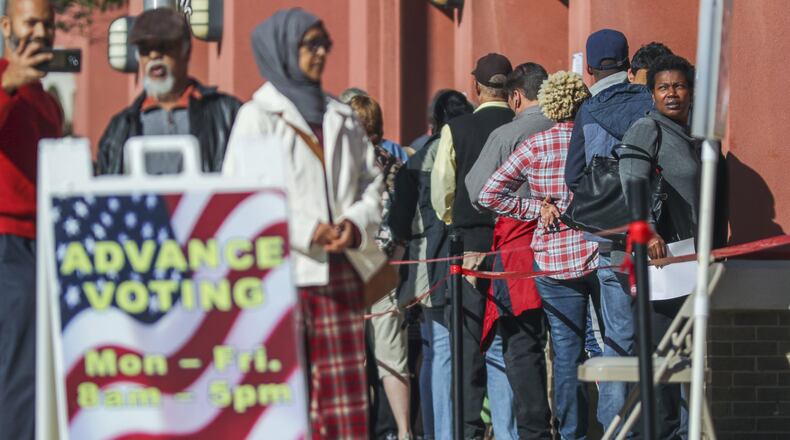A wave of people signed up to vote in Georgia last year, adding 322,000 active voters to the rolls ahead of a presidential election in an increasingly competitive state.
Many of these incoming voters are young and racially diverse, according to voter registration data from the secretary of state’s office. Nearly one-third of Georgia’s voters are under 35 years old. Most Georgia voters are white, but their majority is gradually shrinking each year.
The rising number of voters from demographic groups that tend to support Democrats could make the Republican-leaning state more of a battleground than ever, with a presidential race, two U.S. Senate seats and three open U.S. House seats on the ballot this year. Georgia's presidential primary is March 24.
There are now nearly 7.2 million registered voters in Georgia, a 3% increase in one year.
The number of Georgia voters in the 18-34 age group has jumped 68% since October 2016, according to an Atlanta Journal-Constitution analysis of the state’s voter lists. That group now makes up 31% of the state’s total.
Meanwhile, the portion of the electorate that is white has fallen since 2016. White voters still make up a majority, accounting for 59% of those who identified their race when registering, but that number slipped from 62% four years ago.
The most significant increases were among Hispanic and Asian voters, which are growing quickly but make up a relatively small portion of the state’s voting population, about 6%. Black voters held steady at 33% of Georgia’s electorate.
"In every way, that benefits the Democratic Party," said Scott Hogan, the executive director of the Democratic Party of Georgia. "Georgia is in play. The state is going to go blue. It's just a matter of when: this year."
Republicans say they’ll also appeal to new voters, many of whom moved to Georgia for jobs that exist because of the state’s strong economy.
“People who move here because of job opportunities are natural Republican voters because the Republican Party is the party of growth and opportunity,” GOP Chairman David Shafer said. “We have a great story to tell new Georgians, and I firmly believe that when we tell them, a majority will honor our candidates with their votes.”
The trend of more young, transient and more diverse voters favors Democrats, but it remains unclear when Democrats will start winning major elections, Kennesaw State University political scientist Kerwin Swint said.
No Democrat has won a statewide election in Georgia since 2006. But the 2018 race between Democrat Stacey Abrams and Republican Brian Kemp was the closest election for governor in Georgia since 1966.
“The opportunity is certainly there for Democrats. Sometimes it depends on turnout. Can you get those young voters to the polls?” Swint said. “Even when it happens, I think Georgia is going to be more purple. Republicans are going to be competitive in statewide elections, but they won’t be dominating.”
Younger voters generally turn out less consistently than older voters, Swint said. But the proportion of active voters 65 and older in Georgia has declined from 24% in 2016 to 19% today, according to the AJC’s analysis of voter lists.
Where new voters came from
There are two main reasons for Georgia's flock of new voters: automatic voter registration at driver's license offices and population growth.
About 350,000 new voters have registered each year through automatic voter registration since it began in September 2016, according to state registration data. Eligible voters are registered when they apply for their driver’s licenses unless they check a box opting out of the program, adding almost 1.1 million voters to the rolls since 2017.
Migration into Georgia plays a significant role as well, but voter registration is growing faster than the state’s population. The number of active voters has risen by about 2.5% annually since October 2016, while the state’s population as a whole increases about 1% each year.
Anna Hall, an 18-year-old who works part time as a door-to-door canvasser for the Democratic Party of Georgia, said she thinks younger voters will be motivated to make a difference this year. She plans to vote for the first time in next month’s presidential primary.
“My vote counts more than ever before in tipping the scales,” said Hall, a freshman at Georgia State University who plans to major in political science. “Our political system is changing. The issues are really going to be affecting us more than any other generation. Climate change is a ticking clock.”
Voter registration drives are also attempting to reach Georgians ahead of this year’s election.
The Voter Participation Center, a group that targets unmarried women, people of color and people under 38 years old, mailed voter registration applications to more than 915,000 Georgians last month, said Jessica Barba Brown, the organization's CEO. Even if the response rate is relatively low, that could amount to thousands of new voters.
Many of those potential voters sought by the Voter Participation Center, 42%, moved since the last presidential election in 2016, she said.
“That’s a huge number of people who need to be re-registered, and a lot of those people have moved to Georgia,” Brown said. “Georgia is a top-tier state for us. We’re looking to Georgia as a bellwether.”
Outpacing registration cancellations
About 68% of Georgia’s 10.6 million residents are now registered to vote.
The number of new voters in Georgia has outpaced voter registration cancellations.
Election officials canceled about 287,000 registrations in December and 560,000 in 2017 because those voters hadn't participated in elections for several years, they notified the U.S. Postal Service they had changed their address, or mail from election officials was undeliverable.
Even after accounting for the cancellations, the state’s voter rolls increased by 274,000 since before the 2017 registration removals.
Georgia’s population is growing across all age groups, said Mike Carnathan, manager of research and analysis for the Atlanta Regional Commission.
Young voters might be gaining ground because they’re registering for the first time or moving into Georgia, while many older voters are already registered, he said.
“We’re seeing an aging cohort that’s majority white, and then you’ll see an increasing younger age cohort that majority nonwhite,” Carnathan said. “That’s exactly what the future of metro Atlanta holds when it comes to the composition of the population.”
The same demographic trends hold true across Georgia and the United States, he said.
Whether changes in the makeup of Georgia’s registered voters will result in different election outcomes remains to be seen. Republicans currently control the governor’s office, every statewide office, the state House, the state Senate and both U.S. Senate seats.
But the gap between Republican and Democratic candidates has narrowed in recent years. Since Republican Gov. Nathan Deal won by 10.5 percentage points in 2010, each election for governor and president has grown closer.
In 2018, the race for governor between Kemp and Abrams was decided by 1.4 percentage points — about 55,000 votes.
By the numbers
Almost 7.2 million people are registered to vote in Georgia, an 8% increase since October 2016.
Georgia’s voter rolls have consistently grown because of the state’s automatic voter registration program and population growth. Many of the increases are among young and nonwhite voters.
322,000: Increase in active voters last year
68%: Growth in voters under 35 since 2016
0%: Change in voters 65 and older since 2016
1.1 million: New voters signed up through automatic voter registration at driver's license offices
About the Author
Keep Reading
The Latest
Featured





